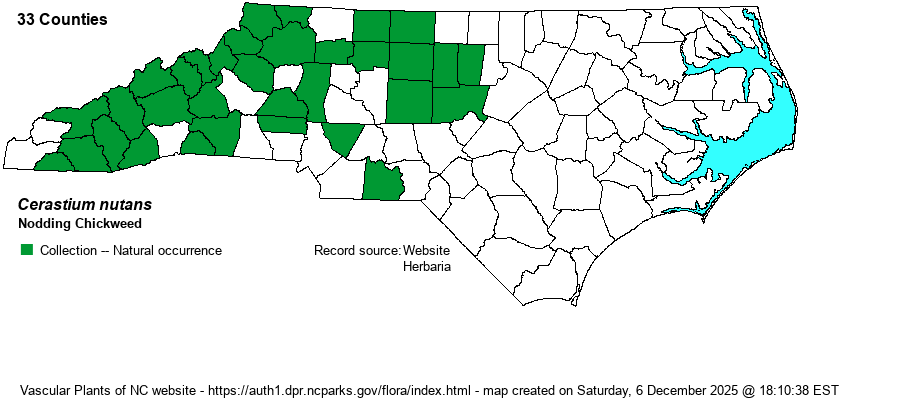| Section 6 » Order Caryophyllales » Family Caryophyllaceae |
Show/Hide Synonym
| taxonName | relationship | relatedTaxonName | relatedTaxonRefText | relComments |
|---|
|
|
|
|
|
| Cerastium nutans | = | Cerastium nutans var. nutans | Gleason (1952) | | | Cerastium nutans | = | Cerastium nutans var. nutans | Kartesz (1999) | | | Cerastium nutans | = | Cerastium nutans var. nutans | Radford, Ahles, and Bell (1968) | | | Cerastium nutans | = | Cerastium nutans var. nutans | Wofford (1989) | | | Cerastium nutans | < | Cerastium nutans | Gleason and Cronquist (1991) | | | Cerastium nutans | < | Cerastium nutans | | | | Cerastium nutans | > | Cerastium nutans var. nutans | Flora of North America (1993b, 1997, 2000, 2002a, 2002b, 2003a, 2004b, 2005, 2006a, 2006b, 2006c, 2007a, 2009, 2010) | | | Cerastium nutans | > | Cerastium longepedunculatum | Small (1933, 1938) | | | Source: Weakley's Flora |
|
| Author | Rafinesque | |
| Distribution | Throughout the Mountains; scattered in the western and central Piedmont, east to Orange, Chatham, and Anson counties.
This is a widespread species across the continent, south in the mountains and Piedmont to central GA and OK. It is essentially absent in Coastal Plains. | |
| Abundance | Fairly common in the Mountains, but rare to uncommon in the Piedmont, and quite scarce in the southern Piedmont. This is a Watch List species in NC, as the species appears to have declined in NC over the past decades, and few records are recent, perhaps simply due to collecting apathy. | |
| Habitat | This is a species of moist and usually shaded places, growing in bottomlands, cove forests, and other similar places. However, all species in the genus, almost all non-native in NC, tend to grow in at least partial sun, and many collections are from road margins, wooded edges and openings, and other moist or rich places away from forest cover. | |
| Phenology | Blooms in April and May, and fruits soon after flowering. | |
| Identification | This is a quite slender species, growing mostly in a leaning manner, to about 10-12 inches long, with some branching. The stem is somewhat pubescent. The scattered stem leaves are opposite. The leaves are elliptic to lanceolate, sessile to nearly clasping, about 1.5-2 inches long and 1/4-inch wide, with a somewhat acute tip. The inflorescence is very open and wide, somewhat cyme-like, with scattered flowers on branch tips. In this species, each flower is on a very long and slender pedicel of 1-1.5 inches long, much longer than the flower and capsule. The sepals are about 1/5-inch long and pointed, and the 5 white petals -- each strongly bisected at the apex -- are as long as or slightly longer than the sepals; they may be spread open or not. Petals may be lacking on some flowers or plants, so do not expect to see obvious white flowers on these plants. The flowers, and especially capsules, are held horizontally or drooping, and as the pedicels are quite long and slender, the effect is often quite attractive, like a swan head on a very slender neck. The very similar C. brachypodum, often (or formerly) considered as a variety of C. nutans, has quite short pedicels -- 3-15 mm (often about 1/2-inch) -- as opposed to ones well over 1-inch long in C. nutans. That species also has shorter leaves than on C. nutans, but look mainly at the length of the flower stalks to separate these. Note that this other species is quite poorly known in VA and NC, and is either very rare or very poorly collected -- if not difficult to identify from herbarium collections. Also, you are more likely to have difficulty separating these species from several non-native species, which are much more common in the state though more often to be in full sun and in disturbed places. These have quite hairy sepals, of if sepals lack such long hairs, the leaves are mostly less than 2/3-inch long. | |
| Taxonomic Comments | RAB (1968) and some others named this species as a variety -- C. nutans var. nutans, but most references have split these two entities into separate species.
| |
| Other Common Name(s) | None | |
| State Rank | S2S3 | |
| Global Rank | G5 | |
| State Status | W7 [W1] | |
| US Status | | |
| USACE-agcp | FACU link |
| USACE-emp | FAC link |

